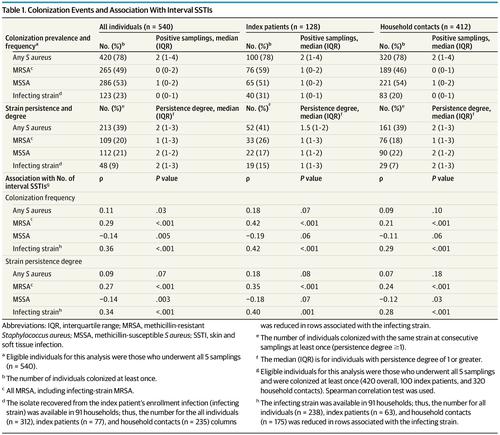当前位置:
X-MOL 学术
›
JAMA Pediatr.
›
论文详情
Our official English website, www.x-mol.net, welcomes your feedback! (Note: you will need to create a separate account there.)
Environmental Methicillin-resistant Staphylococcus aureus Contamination, Persistent Colonization, and Subsequent Skin and Soft Tissue Infection
JAMA Pediatrics ( IF 26.1 ) Pub Date : 2020-06-01 , DOI: 10.1001/jamapediatrics.2020.0132 Patrick G Hogan 1 , Ryan L Mork 2, 3, 4 , Ryley M Thompson 1 , Carol E Muenks 1 , Mary G Boyle 1 , Melanie L Sullivan 1 , John J Morelli 1 , Caroline V Williams 1 , Nataly Sanchez 1 , David A Hunstad 1, 5 , Juliane Bubeck Wardenburg 1 , Sarah J Gehlert 6 , Carey-Ann D Burnham 1, 5, 7, 8 , Andrey Rzhetsky 9 , Stephanie A Fritz 1
JAMA Pediatrics ( IF 26.1 ) Pub Date : 2020-06-01 , DOI: 10.1001/jamapediatrics.2020.0132 Patrick G Hogan 1 , Ryan L Mork 2, 3, 4 , Ryley M Thompson 1 , Carol E Muenks 1 , Mary G Boyle 1 , Melanie L Sullivan 1 , John J Morelli 1 , Caroline V Williams 1 , Nataly Sanchez 1 , David A Hunstad 1, 5 , Juliane Bubeck Wardenburg 1 , Sarah J Gehlert 6 , Carey-Ann D Burnham 1, 5, 7, 8 , Andrey Rzhetsky 9 , Stephanie A Fritz 1
Affiliation

|
Importance
The longitudinal association among persistent Staphylococcus aureus colonization, household environmental contamination, and recurrent skin and soft tissue infection (SSTI) is largely unexplored to date. Objectives
To identify factors associated with persistent S aureus colonization and recurrent SSTI in households with children with community-associated methicillin-resistant S aureus (MRSA) SSTI. Design, Setting, and Participants
This 12-month prospective cohort study included 150 children with community-associated MRSA SSTI, 542 household contacts, and 154 pets enrolled from January 3, 2012, through October 20, 2015. A total of 5 quarterly home visits were made to 150 households in the St Louis, Missouri, region. Statistical analysis was performed from September 18, 2018, to January 7, 2020. Exposures
Covariates used in S aureus strain persistence and interval SSTI models included S aureus colonization and contamination measures, personal hygiene and sharing habits, health history, activities external to the home, and household characteristics (eg, cleanliness, crowding, home ownership, and pets). Serial samples to detect S aureus were collected from household members at 3 anatomic sites, from pets at 2 anatomic sites, and from environmental surfaces at 21 sites. Main Outcomes and Measures
Molecular epidemiologic findings of S aureus isolates were assessed via repetitive-sequence polymerase chain reaction. Individual persistent colonization was defined as colonization by an identical strain for 2 consecutive samplings. Longitudinal, multivariable generalized mixed-effects logistic regression models were used to assess factors associated with persistent S aureus personal colonization, environmental contamination, and interval SSTI. Results
Among 692 household members in 150 households, 326 (47%) were male and 366 (53%) were female, with a median age of 14.82 years (range, 0.05-82.25 years). Of 540 participants completing all 5 samplings, 213 (39%) were persistently colonized with S aureus, most often in the nares and with the strain infecting the index patient at enrollment. Nine pets (8%) were persistently colonized with S aureus. Participants reporting interval intranasal mupirocin application were less likely to experience persistent colonization (odds ratio [OR], 0.44; 95% credible interval [CrI], 0.30-0.66), whereas increasing strain-specific environmental contamination pressure was associated with increased individual persistent colonization (OR, 1.17; 95% CrI, 1.06-1.30). Strains with higher colonization pressure (OR, 1.47; 95% CrI, 1.25-1.71) and MRSA strains (OR, 1.57; 95% CrI, 1.16-2.19) were more likely to persist. Seventy-six index patients (53%) and 101 household contacts (19%) reported interval SSTIs. Individuals persistently colonized with MRSA (OR, 1.56; 95% CrI, 1.17-2.11), those with a history of SSTI (OR, 2.55; 95% CrI, 1.88-3.47), and index patients (OR, 1.54; 95% CrI, 1.07-2.23) were more likely to report an interval SSTI. Conclusions and Relevance
The study findings suggest that recurrent SSTI is associated with persistent MRSA colonization of household members and contamination of environmental surfaces. Future studies may elucidate the effectiveness of specific combinations of personal decolonization and environmental decontamination efforts in eradicating persistent strains and mitigating recurrent SSTIs.
中文翻译:

环境耐甲氧西林金黄色葡萄球菌污染、持续定植以及随后的皮肤和软组织感染
重要性 迄今为止,金黄色葡萄球菌持续定植、家庭环境污染和复发性皮肤和软组织感染 (SSTI) 之间的纵向关联在很大程度上尚未得到探索。目的 确定与社区相关耐甲氧西林金黄色葡萄球菌 (MRSA) SSTI 儿童的家庭中与金黄色葡萄球菌持续定植和复发性 SSTI 相关的因素。设计、设置和参与者 这项为期 12 个月的前瞻性队列研究包括 2012 年 1 月 3 日至 2015 年 10 月 20 日期间登记的 150 名患有社区相关 MRSA SSTI 的儿童、542 名家庭接触者和 154 只宠物。总共 5 次季度家访密苏里州圣路易斯地区的 150 户家庭。统计分析时间为2018年9月18日至2020年1月7日。金黄色葡萄球菌菌株持续性和间隔 SSTI 模型中使用的暴露协变量包括金黄色葡萄球菌定植和污染措施、个人卫生和分享习惯、健康史、家庭外部活动和家庭特征(例如,清洁度、拥挤、房屋所有权和宠物) )。从 3 个解剖部位的家庭成员、2 个解剖部位的宠物和 21 个部位的环境表面收集了用于检测金黄色葡萄球菌的系列样本。主要结果和措施通过重复序列聚合酶链反应评估金黄色葡萄球菌分离株的分子流行病学发现。个体持续定植定义为同一菌株连续 2 次取样定植。纵,多变量广义混合效应逻辑回归模型用于评估与持续性金黄色葡萄球菌个人定植、环境污染和间隔 SSTI 相关的因素。结果150户692户中,男性326人(47%),女性366人(53%),中位年龄14.82岁(0.05~82.25岁)。在完成所有 5 次采样的 540 名参与者中,213 名 (39%) 金黄色葡萄球菌持续定植,最常见的是在鼻孔中,并且在登记时感染了指示患者的菌株。9 只宠物 (8%) 持续定植了金黄色葡萄球菌。报告间隔鼻内莫匹罗星应用的参与者不太可能经历持续定植(比值比 [OR],0.44;95% 可信区间 [CrI],0.30-0.66),而菌株特定环境污染压力的增加与个体持续定植的增加有关(OR,1.17;95% CrI,1.06-1.30)。定植压力较高的菌株(OR,1.47;95% CrI,1.25-1.71)和 MRSA 菌株(OR,1.57;95% CrI,1.16-2.19)更有可能持续存在。76 名指标患者 (53%) 和 101 名家庭接触者 (19%) 报告了间歇性 SSTI。持续定植 MRSA 的个体(OR,1.56;95% CrI,1.17-2.11)、有 SSTI 病史的个体(OR,2.55;95% CrI,1.88-3.47)和指标患者(OR,1.54;95% CrI) , 1.07-2.23) 更有可能报告间隔 SSTI。结论和相关性 研究结果表明,复发性 SSTI 与家庭成员的持续 MRSA 定植和环境表面污染有关。
更新日期:2020-06-01
中文翻译:

环境耐甲氧西林金黄色葡萄球菌污染、持续定植以及随后的皮肤和软组织感染
重要性 迄今为止,金黄色葡萄球菌持续定植、家庭环境污染和复发性皮肤和软组织感染 (SSTI) 之间的纵向关联在很大程度上尚未得到探索。目的 确定与社区相关耐甲氧西林金黄色葡萄球菌 (MRSA) SSTI 儿童的家庭中与金黄色葡萄球菌持续定植和复发性 SSTI 相关的因素。设计、设置和参与者 这项为期 12 个月的前瞻性队列研究包括 2012 年 1 月 3 日至 2015 年 10 月 20 日期间登记的 150 名患有社区相关 MRSA SSTI 的儿童、542 名家庭接触者和 154 只宠物。总共 5 次季度家访密苏里州圣路易斯地区的 150 户家庭。统计分析时间为2018年9月18日至2020年1月7日。金黄色葡萄球菌菌株持续性和间隔 SSTI 模型中使用的暴露协变量包括金黄色葡萄球菌定植和污染措施、个人卫生和分享习惯、健康史、家庭外部活动和家庭特征(例如,清洁度、拥挤、房屋所有权和宠物) )。从 3 个解剖部位的家庭成员、2 个解剖部位的宠物和 21 个部位的环境表面收集了用于检测金黄色葡萄球菌的系列样本。主要结果和措施通过重复序列聚合酶链反应评估金黄色葡萄球菌分离株的分子流行病学发现。个体持续定植定义为同一菌株连续 2 次取样定植。纵,多变量广义混合效应逻辑回归模型用于评估与持续性金黄色葡萄球菌个人定植、环境污染和间隔 SSTI 相关的因素。结果150户692户中,男性326人(47%),女性366人(53%),中位年龄14.82岁(0.05~82.25岁)。在完成所有 5 次采样的 540 名参与者中,213 名 (39%) 金黄色葡萄球菌持续定植,最常见的是在鼻孔中,并且在登记时感染了指示患者的菌株。9 只宠物 (8%) 持续定植了金黄色葡萄球菌。报告间隔鼻内莫匹罗星应用的参与者不太可能经历持续定植(比值比 [OR],0.44;95% 可信区间 [CrI],0.30-0.66),而菌株特定环境污染压力的增加与个体持续定植的增加有关(OR,1.17;95% CrI,1.06-1.30)。定植压力较高的菌株(OR,1.47;95% CrI,1.25-1.71)和 MRSA 菌株(OR,1.57;95% CrI,1.16-2.19)更有可能持续存在。76 名指标患者 (53%) 和 101 名家庭接触者 (19%) 报告了间歇性 SSTI。持续定植 MRSA 的个体(OR,1.56;95% CrI,1.17-2.11)、有 SSTI 病史的个体(OR,2.55;95% CrI,1.88-3.47)和指标患者(OR,1.54;95% CrI) , 1.07-2.23) 更有可能报告间隔 SSTI。结论和相关性 研究结果表明,复发性 SSTI 与家庭成员的持续 MRSA 定植和环境表面污染有关。



























 京公网安备 11010802027423号
京公网安备 11010802027423号